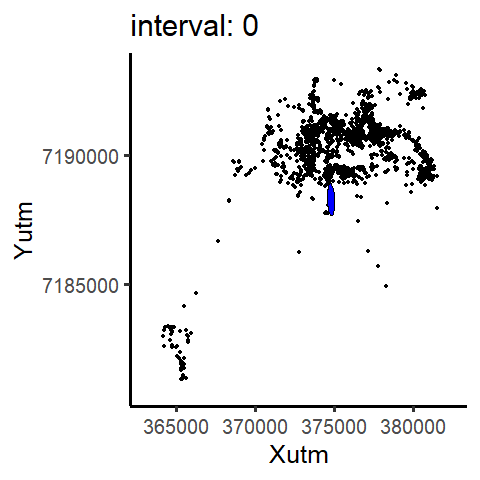
Animal Movement
Home Ranges and Resource Selection
Home range size estimates have a distinct relationship with time. Similarly, resource use has a distinct relationship with space given a species fundamental ecology (e.g. territoriality). Our team (Dr. Garrett Street and Natasha Ellison) at Mississippi State worked to challenge perceptions on home range estimates and resource selection how these could be as flexible as the movement phenomena the capture.

Osprey - Power Infrastructure Conflicts
Given federal legislation to protect migratory birds, power companies aim to mitigate their impacts on migratory raptors such as Osprey. Our team (Dr. Scott Rush and PhD Candidate Natasha Murphy) worked to help the Tennessee Valley Authority mitigate conflict between Osprey and TVA power infrastructure.

Species Interactions
Species interactions may be just as, if not more, important than habitat at describing space use of animals. Biomathematician Natasha Ellison and our team worked to showcase this potential in resource selection analyses. This helped pave the road for incorporating these dynamics for social species or for considering interspecific interactions within RSFs.

Invasive Wild Pigs
Wild pigs are an invasive species which cause billions in damage to our agricultural and natural ecosystems each year. Work on wild pigs is happening on multiple fronts. Our team (including Dr. Ray Iglay, PhD candidate Tyler Evans, and the USFWS) work to investigate wild pig movement and abundance and develop a rapid assessment tool for Mississippi bottomland hardwoods.

Wild pigs are also a threat in newly introduced locations in Canada. In partnership with Dr. Ryan Brook at University of Saskatchewan and the USDA, we worked to understand wild pig movement at northern latitudes.
Fishers in a Fire Prone Landscape
Fishers in California are already threatened and face even more pressures living in a fire prone landscape fueled by climate change. In partnership with Rebecca Green at the Forest Service, and Eric McGregor at the Institute for Natural Resources - Oregon State University, we described how fishers move and use the landscape within the Sierra National Forest to help management decision making.

Tiger Shark Distributions
Given climate change threats to ecosystems, it is critical to understand responses of species to warming. This is especially important in the case of apex predators since they exhibit relatively high extinction risk and distribution changes could impact predator-prey interactions. In partnership with Dr. Neil Hammerschlag at the University of Miami, we investigated the effects of ocean warming on the movement behavior and conservation of a highly migratory shark.

Cattle Impacts on Rangeland Ecosystems
Our team (including postdoctoral associate Stephanie Cunningham and USDA-ARS researcher David Augustine) used high-frequency accelerometer and location data from beef cattle to understand the effects of rangeland management techniques on production and ecosystem change. This enormous amount of data allowed us to make recommendations on optimal monitoring efforts required by producers to efficiently manage herds.

Catfish biologging calibration
The use of technology in new systems requires careful quantity control and calibration before large scale deployment. To ensure that we can examine catfish behavior in murky pond waters effectively, our team worked to calibrate various biologging tech (e.g. accelerometers) for use in catfish production systems. We looked into how best to implant, deploy, and retrieve devices, as well as how to translate signals to measures of activity, metabolism, and space use.

Deer-deer and deer-pig interactions
Discovered in Mississippi in 2018, CWD is now spreading within the state. Transmission of this fatal disease is likely influenced by deer-deer social interactions, as well as negative interactions with competitors such as wild pigs. Working in collaboration with the Mississippi Department of Wildlife, Fisheries, and Parks, our team aimed to quantify the frequency and spatial influences that encourage these interactions.

Carp
Invasive fish are notably challenging to detect due to the substantial fishing effort they require, particularly over vast regions. This hinders efforts to understand, forecast, and manage the proliferation of species such as bigheaded carps. We used local ecological knowledge predict bigheaded carp distribution in the Mississippi Alluvial Valley. The resultant map offers a baseline resource for identifying priority management areas and can serve as a first step in conservation planning.
